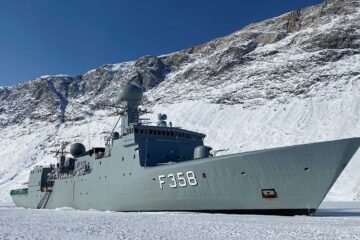This procurement process is supporting capability requirements set out in a supplement to the current Danish Defence Agreement (which covers the 2018-23 period). The supplement, known as ‘The Arctic Capability package’, was published in February 2021.
“The work for implementing the agreement has already begun,” Commodore Claus Andersen, a Royal Danish Navy (RDN) officer and Deputy National Armaments Director in Denmark’s Defence Acquisition and Logistics Organisation (DALO), told the SAE Media Group Maritime Reconnaissance and Surveillance Technology conference, held in London on 1-2 February.
Two key steps were taken in 2022, said Cdre Andersen.
First, DALO issued a tender for a medium-altitude/long-endurance, long-range uncrewed aerial vehicle to provide surveillance and intelligence capability. Tender bids are currently being assessed, with contract award anticipated in 2023.
Second, the Joint Arctic Command Denmark (JACO) – headquartered in Nuuk, southwestern Greenland – is being certified as a test and evaluation centre for new surveillance technologies to be operated in the region. “The JACO upgrade will be finalised in the first half of 2023: the basic architecture will be stood up,” Cdre Andersen said. This architecture upgrade includes enhancing JACO’s command-and-control (C2) capabilities.
The C2 upgrade includes the TERMA JIMAPS C4ISR system, and a Systematic SitaWare-based solution, Cdre Andersen told Naval News on 9 February.
Under the capability package, Denmark committed to invest in new technologies – especially uncrewed systems, communications, and data analysis – to improve surveillance, presence, and other outputs to support national and NATO Arctic interests.
Delivering improved presence and surveillance will be underpinned by new technology, which in turn will be underpinned by wider digital transformation across Denmark’s defence capability and infrastructure, Cdre Andersen told the conference. “[JACO] headquarters will serve as a basis for tests and trials on the digital transformation of the Danish armed forces,” he explained.
Denmark’s Arctic and wider North Atlantic interests range from Denmark itself, to the Faroe Islands, up to and across Greenland, and including the Greenland-Iceland-UK (GIUK) Gap. The current deterioration in regional security means military activity there is increasing.

For Denmark, the region’s geographic distances, different domains (air, land, and sea), and various sensing capabilities already deployed and being developed underline the importance of integrated C2. For example, Cdre Andersen explained:
“The challenge in Greenland is there is a lot of data out there already: [the issue] is getting it from the sensors to [JACO] headquarters.”
A new ground station ashore in Greenland will play a key role in downloading satellite data from new space-based surveillance capability. Broadband data bandwidth will be added to increase data flow. Edge computing capability will be used to reduce bandwidth requirements for transmitting data from sensors to headquarters.

Remaining projects to be taken forward under the package will progress in parallel, with requirements drawn up in 2023 to prepare for issuing of tenders, Cdre Andersen told Naval News.
These projects include: setting up a surveillance radar on the Faroe Islands; increasing uncrewed capabilities onboard RDN frigates and patrol vessels operating in Arctic regions; enhancing tactical datalinks between these ships and their embarked MH-60R Seahawk helicopters; and improving data analysis capability.
Such enhancements, especially integrated C2, will enable wider Danish contributions to NATO Arctic activities, Cdre Andersen told the conference.
As security, climate, and economic factors in the Arctic increase in significance, so the region will remain a Danish defence policy priority into the next defence agreement, covering the 2024-33 period. This agreement, which is being developed in the first half of 2023, is expected to focus on rapid delivery of military technology, in partnership with allies, to support NATO capability targets, said Cdre Andersen. Likely areas of focus include continued digital transformation to support enhanced maritime domain awareness, improved maritime air and surface ship patrol capability, increased use of uncrewed vessels, and greater SATCOM capability.
“It is expected that towards 2033, Danish Defence must increase its investment in the Arctic, especially with a view to better monitoring Greenland’s sea space and land territory, and more systematic assertion of sovereignty in the air as well as on and under the sea.”
Commodore Claus Andersen, a Royal Danish Navy (RDN) officer and Deputy National Armaments Director in Denmark’s Defence Acquisition and Logistics Organisation (DALO)






